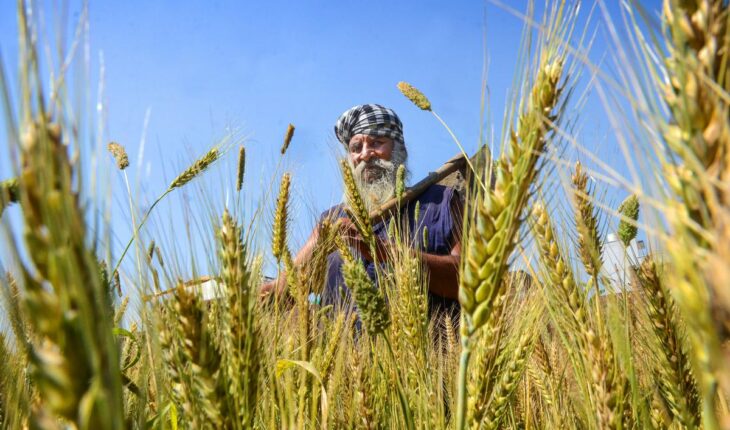
Wheat plays a critical role in national food security not only in India but also globally as it is the second largest producer in the World, contributing to 13% of the global wheat supply. With temperatures very likely to rise in these years, a fall in yield is likely for many wheat-production regions in the world. In Feb 2023 and last year in March, the temperature in the states has been three to five degrees above normal. According to agriculturists every one-degree rise in temperature causes damage to the wheat crop and affects its yield. This year wheat production in Punjab and Haryana, which are the third and fourth highest wheat producers in the country, is very significant as depleting wheat stocks in the Central pool, caused by the low wheat production and government procurement last year. Haryana contributes 13.3% towards the national wheat production, with an average productivity of nearly 4 tonnes/hec. The area and productivity, averaged over the last five years are 2.3 million tonnes and 4 tonnes/ha. respectively. The trend during the last five years has shown a marginal decline in production from the nearly stable areas of cultivation. Wheat production in the state has declined due to reduced soil organic carbon status, nutrient mining, imbalanced fertilization, crop residue burning leading to nutrient and organic carbon loss and a declining water table, but early warm weather has become the major reason for low productivity for the last five years.
Rising temperatures due to climate change are a major driver of wheat loss in the Indo-Gangetic Plains (Haryana, Punjab, Uttar Pradesh)with important implications for food security in this highly populated and vulnerable region. Probabilistic estimates of below-average wheat production under scenario-averaged heat stress conditions are expected to rise by 8%–27% under the SSP5-8.5 scenario, with Punjab showing the largest increase. Quantitative links between heat stress indicators and loss of crop yield highlight increased agricultural vulnerability in India under climate change
The global events of the last year, especially during the Russia-Ukraine war, have again shown the importance of food security to the world. It is critical for India too as it has to provide food to a large population of about 1.39 billion people and has to distribute wheat under Public Distribution System. Punjab and Haryana continue to be the leading states in contributing to central pool stocks of food grains. It must be recalled that wheat production last year too was adversely impacted due to unusually warm weather in March and April 2022. Due to a smaller wheat crop, the government could not procure the required quantity of wheat last year. In fact, the wheat procurement was only 187.9 LMT (Lakh Metric Tonnes), down from 433.4 LMT in the previous year; and (ii) wheat stocks in the central pool are at their 14-year low levels. Punjab (96.45 LMT) and Haryana (41.86 LMT) were the most important contributors of wheat procured this year. The two states accounted for 73.6 per cent of wheat procured. Both Punjab and Haryana continue to play the role of dominant yet stable and consistent suppliers of these grains to the central pool. This year, the area under wheat crop is 34.90 lakh hectares. Based on the initial data, the government is expecting that the wheat production in the state would be around 167-170 lakh metric tonnes (LMT). Of this, 120-130 LMT of wheat is expected to be brought to the mandis for government purchase.
Last year, however, wheat production had fallen sharply to 148 LMT because of heavy rain in January and abnormally high temperatures in March. The procurement from the state was at a record low at 95 LMT. As the global shortage of wheat continues this year too (because of the Russia-Ukraine war), a good harvest is of prime concern to the state as well as the Central government.
During the Covid-19 pandemic, the government could provide additional food grains, free of cost, under the PradhanMantriGaribKalyan Anna Yojana (PMGKAY) only due to the excessive procurement of wheat and rice in the previous four years.
Lower production will also pull down the procurement of rice. As of 10 November, 231.28 lakh metric tonnes of paddy have been procured. This will deliver about 154.9 LMT of rice (one quintal of paddy gives about 67 kg of rice). Last year, on this date, the procurement in terms of rice was 152.8 LMT
In 2021-22, 43.91 LMT of rice was procured in UP. This year, the estimated procurement in the state is 40 LMT. Both east and west UP received lower rainfall, especially in July and August. Therefore, the paddy production was lower than last year.
Since the Public Distribution System is continuing in its present form and there is no roadmap to move to direct benefit transfer of food subsidy, the Union government will continue to depend on the procurement of wheat and rice at MSP.
Many states are making efforts to encourage the production and procurement of pulses like arhar, moong and urad. These states can undertake such procurement under the government’s Price Support Scheme (PSS) but they are only allowed to procure 25 per cent of their production.
Price incentives are critical for farmers and if these incentives continue to work only for rice and wheat, diversification to less water-consuming (millet) crops will not be found attractive by the farmers. In the era of climate change, if Punjab and Haryana do not produce enough surplus rice and wheat, the food security for basic staples itself may be under threat.
We have to strategise on a set of practices to be adopted by farmers in case the temperatures rise abnormally. Farmers should be asked to go in for a spray of potassium nitrogen to mitigate any loss in yield because of a heat wave. Farmers have been asked to remain vigilant about yellow rust. high temperature is a temporary phase and because of cooler nights, there won’t be much impact on the yield
Meanwhile, Punjab Agricultural University too is working on new irrigation practices in case the day temperatures continue to move skywards.
Simulated results showed that terminal heat stress will reduce wheat yield by 18.1%, 16.1% and 11.1%, respectively in present, 2025 and 2050 scenarios. Advancement in sowing date, application of an additional dose of nitrogen and irrigation at the grain filling stage were found suitable options for preventing yield loss. Among various combinations of adaptation options, early sowing by 10 days from recommended sowing date with 30 kg ha⁻¹ additional nitrogen fertilizer and one additional irrigation at the grain filling stage was found most suitable. Adaptation of these strategies will help in reducing the impact of heat stress by 7.5, 6.4 and 9% respectively in present, 2025and 2050 heat stress scenarios.
Dr.HarvinderKaur, Associate Professor in Economics, Ambala, views are personal






